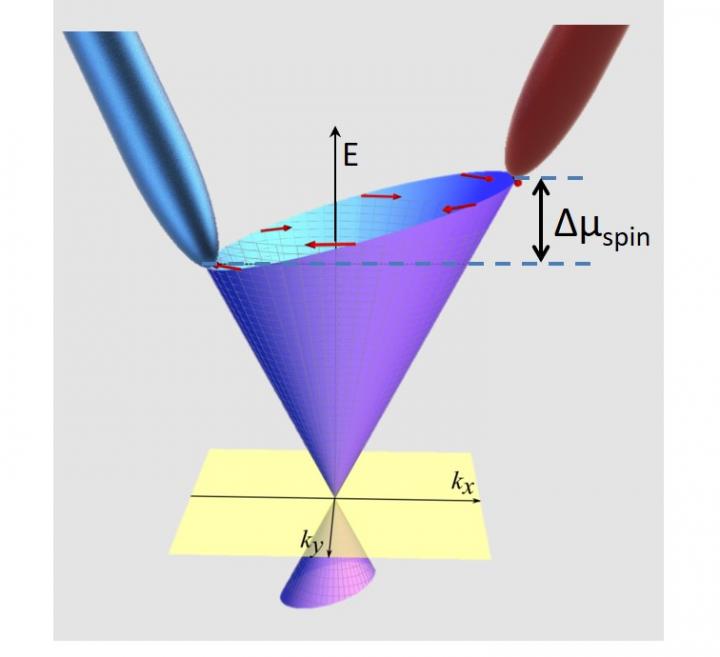Spin current detection in quantum materials unlocks potential for alternative electronics

An ORNL-led team successfully detected and measured a voltage created as electrons, exhibiting quirky particle behavior called spin current, moved across the surface of a quantum material. Credit: Saban Hus and An-Ping Li/Oak Ridge National Laboratory, U.S. Dept. of Energy
Found at the heart of electronic devices, silicon-based semiconductors rely on the controlled electrical current responsible for powering electronics. These semiconductors can only access the electrons' charge for energy, but electrons do more than carry a charge. They also have intrinsic angular momentum known as spin, which is a feature of quantum materials that, while elusive, can be manipulated to enhance electronic devices.
A team of scientists, led by An-Ping Li at the Department of Energy's Oak Ridge National Laboratory, has developed an innovative microscopy technique to detect the spin of electrons in topological insulators, a new kind of quantum material that could be used in applications such as spintronics and quantum computing.
“The spin current, namely the total angular momentum of moving electrons, is a behavior in topological insulators that could not be accounted for until a spin-sensitive method was developed,” Li said.
Electronic devices continue to evolve rapidly and require more power packed into smaller components. This prompts the need for less costly, energy-efficient alternatives to charge-based electronics. A topological insulator carries electrical current along its surface, while deeper within the bulk material, it acts as an insulator. Electrons flowing across the material's surface exhibit uniform spin directions, unlike in a semiconductor where electrons spin in varying directions.
“Charge-based devices are less energy efficient than spin-based ones,” said Li. “For spins to be useful, we need to control both their flow and orientation.”
To detect and better understand this quirky particle behavior, the team needed a method sensitive to the spin of moving electrons. Their new microscopy approach was tested on a single crystal of Bi2Te2Se, a material containing bismuth, tellurium and selenium. It measured how much voltage was produced along the material's surface as the flow of electrons moved between specific points while sensing the voltage for each electron's spin.
The new method builds on a four-probe scanning tunneling microscope–an instrument that can pinpoint a material's atomic activity with four movable probing tips–by adding a component to observe the spin behavior of electrons on the material's surface. This approach not only includes spin sensitivity measurements. It also confines the current to a small area on the surface, which helps to keep electrons from escaping beneath the surface, providing high-resolution results.
“We successfully detected a voltage generated by the electron's spin current,” said Li, who coauthored a paper published by Physical Review Letters that explains the method. “This work provides clear evidence of the spin current in topological insulators and opens a new avenue to study other quantum materials that could ultimately be applied in next-generation electronic devices.”
###
Additional coauthors of the study titled, “Detection of the Spin-Chemical Potential in Topological Insulators Using Spin-Polarized Four-Probe STM,” include ORNL's Saban Hus, Giang Nguyen, Wonhee Ko and Arthur Baddorf; X.-G. Zhang of the University of Florida; and Yong Chen of Purdue University.
This research was conducted at the Center for Nanophase Materials Sciences, a DOE Office of Science User Facility. The development of the novel microscopy method was funded by ORNL's Laboratory Directed Research and Development program.
ORNL is managed by UT-Battelle for DOE's Office of Science. The Office of Science is the single largest supporter of basic research in the physical sciences in the United States, and is working to address some of the most pressing challenges of our time. For more information, please visit http://science.
Media Contact
All latest news from the category: Materials Sciences
Materials management deals with the research, development, manufacturing and processing of raw and industrial materials. Key aspects here are biological and medical issues, which play an increasingly important role in this field.
innovations-report offers in-depth articles related to the development and application of materials and the structure and properties of new materials.
Newest articles

NASA: Mystery of life’s handedness deepens
The mystery of why life uses molecules with specific orientations has deepened with a NASA-funded discovery that RNA — a key molecule thought to have potentially held the instructions for…

What are the effects of historic lithium mining on water quality?
Study reveals low levels of common contaminants but high levels of other elements in waters associated with an abandoned lithium mine. Lithium ore and mining waste from a historic lithium…

Quantum-inspired design boosts efficiency of heat-to-electricity conversion
Rice engineers take unconventional route to improving thermophotovoltaic systems. Researchers at Rice University have found a new way to improve a key element of thermophotovoltaic (TPV) systems, which convert heat…



